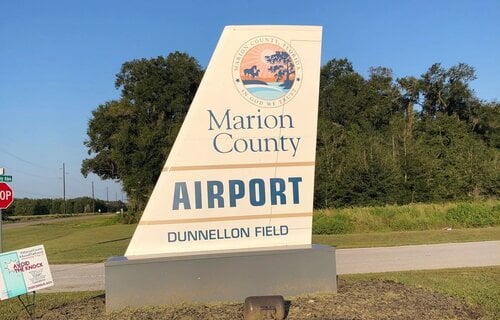 TRAINING DAY 1
TRAINING DAY 1
October 17, 2020|Paramotor, PPG, Training
The day has finally arrived, I’m headed over to Dunnellon to start my training at Aviator PPG. To say I am excited is an understatement. My head is swimming with so many questions and I am thrilled to receive training from people that are equally excited about this sport.
The day started at 9am. I arrived about 15 minutes early because, well, excited. We all did some initial paperwork – signing our lives away and other indemnification clauses. Grabbed some fresh brewed coffee and then settled in for our initial class session.
Most of the day was spent in the class learning the basics of powered paragliding. That covered terminology, riser anatomy, wing anatomy, and some general flight expectations. Beyond the class discussions, we clipped in, selected our student paramotors, did our hang point setup, and practiced kiting. For lunch, the Aviator PPG crew made us chicken tacos. Damn, those were delicious.
As an added bonus, Tucker and Jacquline were in town and stopped by to visit. I didn’t really get to talk with him and missed an opportunity to get a picture. Next time.
We wrapped up the day with a demo from Eric Farewell, Judson Graham, and Bo Feldman gave us an impromptu demo. The wind wasn’t very cooperative and made it challenging to fly, but these guys managed to give us quite the show.
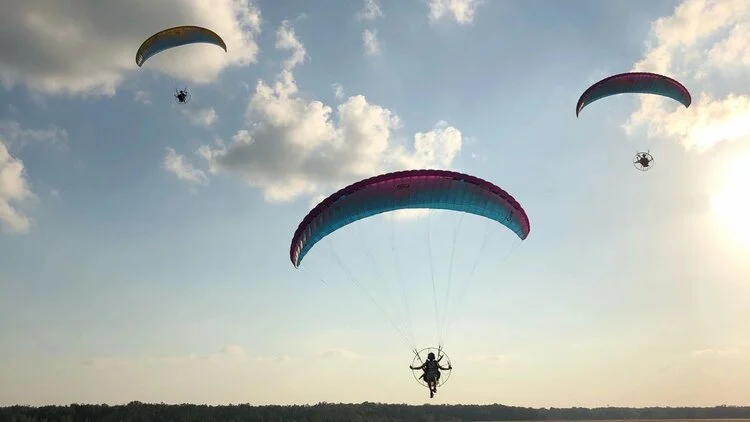
TRAINING DAY 2
October 18, 2020| Paramotor, PPG, Training

Today was a very tough day, both physically and emotionally. We started early at 7:15am with some ground handling. The wind was a lot better than it was yesterday afternoon. I think it was blowing steady at about 5mph. Enough to get the wings up and do both forward and reverse kiting. I’ve gotten a lot better on the reverse launches but the forward is always easier, which is good since we always take off from the forward position.
We also did a tandem flight on the trike around 8:00am. I’m essentially sitting in small seat between the pilot’s legs with both our feet on a single forward wheel used for steering while on the ground. To say I was nervous would be an understatement. I’ve never flown in an ultralight before today. The closest would be a small Cesna plane I flew in Hawaii once. It was super turbulent and I had white knuckles the whole time. I had been anxious about the trike flight all morning. Waking up super early didn’t help things. But this is why I came here, to take training and get into the air.
Judson, one of the instructors, was the pilot. We taxied and got up fairly easily – surprisingly so, these paramotors get up into the air so quickly. I’m not sure how high we went. We were well above the trees. It felt like 200 feet but maybe it was less, maybe it was more. Either way, I had a death grip on the side bars. When Judson asked me to take the brakes to steer, I had to force myself to let go of the bars and reach back to take the brakes. I was petrified to the point it was difficult to follow instruction.
As we turned to the right for the pattern, the wing would roll slightly right and your first instinct is to grab the bar again. I had to fight that feeling to remain in control. Judson did a touch and go, then back up we went. He did a few oscillation maneuvers to demonstrate how to regain control both passively (do nothing, let the wing do its thing) and actively (take control by applying break to one side). Honestly, I was so nervous I had a difficult time following along. There were a few times I couldn’t quite hear or understand what Judson was saying and he had to take control. We did a few s-turns (yikes) to decrease altitude and then came in for a landing.
I’ve spent the entire day reflecting on that experience. While the other students were elated at the experience, I felt uncertain and unsure about myself, my abilities, and whether I will ever be able to fly solo. I had hoped a progressive training program that eases me into the air would help with my fears but I’m not certain that’s happening. Then again, this was only the second day of training. Perhaps more exposure will help. I’m trying not to be bummed at my fearful experience, I remain determined to see this through, but I’m now hesitant and unsure about the outcome.
We wrapped up the day doing the simulator, which gives us the experience of flight without actually flying. You’re sitting in the seat with the motor running and then go through throttle exercises to get a feel for power and comms during flight. Then we walked around with the engine on our back at various throttle intensities to get a feel for leaning back at throttle – trust the thrust to keep you up even when leaning way back. That’s difficult for sure. You have to fight the urge to lean forward so you keep the thrust line pointing back or, better yet, pointing down.
Tomorrow (day 3), we are doing more ground handling and then tow launches. This will give us the experience of flight without the motor. The thrust will be provided by the wench. I’m not sure if we’re doing any more tandem flights right away. Micah, lead instructor, said we will most likely transition to heavy days of classroom lectures since the weather may not be ideal. It’s Florida so we’ll see how the weather plays out.
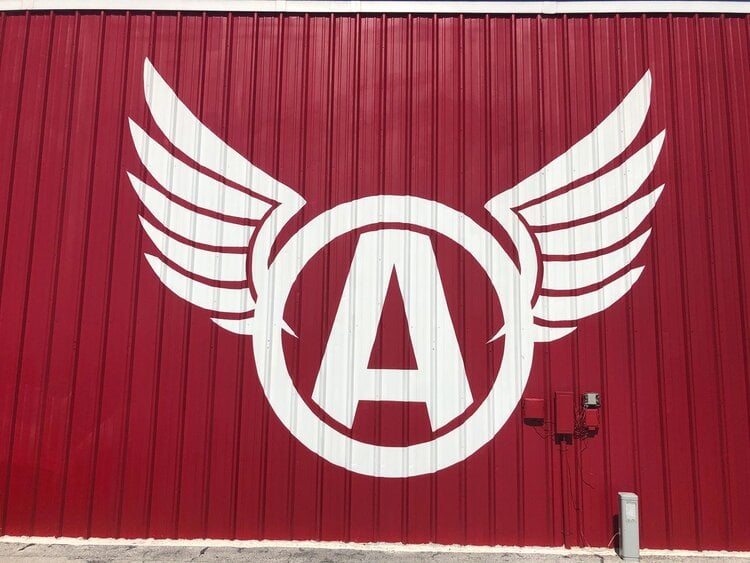
TRAINING DAY 3
October 19, 2020|Paramotor, PPG, Training
We were supposed to do towing today but the weather wasn’t cooperating. Instead, we opted to do more ground handling. I’m grateful that we did, I spent three hours perfecting forward and reverse launches. i truly believe I’m getting better, especially at reverse launches.
Just the Tip
Finally, focusing on “just the tip” has finally paid off In more than a bad joke. Using the wing tip when ground handling can help keep the wing overhead. This was a game changer today. I use the tip of the wing to gauge where the wing is in relation to the horizon. That made things WAY easier and nearly all my launches went well today. Thanks to Judson Graham for being patient and helping me find my stride.
We broke for a long lunch and resumed early afternoon for some class lecture. We covered airport operation that included how to properly navigate and communicate with and airport. And then we covered weather. The weather is critical since ultralights are susceptible to small changes in weather. Knowing what to look for ensures we are safe.
We had planned to do more ground handling but unfortunately the weather turned bad, so we ended the day and will focus on tomorrow. Depending on the weather, we may try towing again. If not, we may do more ground handling or more class work. We’ll see…
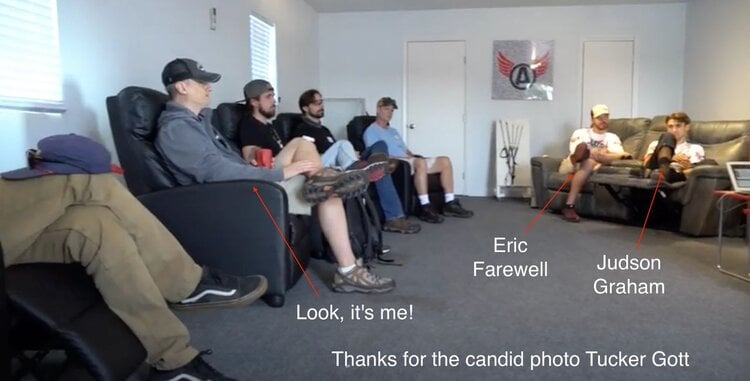
TRAINING DAY 4
October 20, 2020|Paramotor, PPG, Training
I managed to sleep until about 6am, which was about 30 minutes longer than the past few days. Since I got up early, I stopped by Dunkin Donuts to grab some food for everyone. Funny, Micah did the same thing. I guess great minds think alike.
A couple of donuts and a coffee down, we headed out to the field for some ground handling. The wind couldn’t have been better. We did some kiting for about 2 hours. Things went really well. My kiting technique is getting better every day. I am reverse and forward launching and alternating between the two in motion. At one point, I kited the wing back to where I started without losing control.
Around 10am, we headed in for a debrief and then start a bit of class lecture. Todays discussion centered around wing dynamics. We covered the difference between a paragliding wing and a parachute – two very different canopies. We also discussed risers, specifically around how trimmers work, how the speed bar works, and to never pull breaks when trimmers are out and you’re using the speed bar. There are, as with everything, exceptions to that rule but its a good rule to follow.
We broke for lunch, eating as a team at this Greek place not far from the airport. The food was amazeballs. If you’re ever in the area, I highly recommend checking out this place for a gyro. You won’t be disappointed.
After lunch, we reconvened for more class lecture on airspace. This covers how to navigate airspace based on classes (A, B, C, D, G, and E) as well as things that may prevent access to various airspace due to activities (e.g. president flying in/out, big events) or temporary flight restrictions (TFRs). This was just an introductory class. There is a LOT of information. It will take time and ongoing study to completely understand how to properly navigate the airspace; however, this introductory course will help us avoid getting into trouble. We had planned to do some kiting to wrap the day but we had a downpour hit so we broke for the day.
We’re looking to do more ground handling and class room lecture tomorrow. There’s talk of towing on Friday along with a possible tandem. I’m trying not to think too much about these so I don’t get anxiety ahead of the actual event. Everything depends on the weather. And in Florida, the weather can be difficult to predict.

TRAINING DAY 5
October 21, 2020|Paramotor, PPG, Training
Today was another tough day. Both physically and mentally.
Let’s cover the physical exertion first. We started off with ground handling practice. Unfortunately, the wind was nearly zero and that made wing inflation difficult. We did a lot of running to inflate and maintain stable forward momentum. Worse, there was a little dew on the ground making the wing wet. Each launch was that much more difficult because the wing is heavier as it gets wet. Needless to say, trying to kite in no wind situations (and a slightly wet wing) pretty much sucks. It’s a good thing there’s usually a breeze here in Florida. My leg muscles are burning a bit. It has been many years since I’ve had to move this quickly. Exercise, what’s that?
Honestly, I would compare this training to Marine Corps bootcamp. There is a physical and mental aspect to bootcamp. While I felt the mental aspect was easier to overcome compared to the physical aspect at bootcamp, the opposite seems true compared to the PPG training. Perhaps the physical demand of bootcamp prepared me better for the PPG training. At this point, running and lifting 60-80 pounds on your back is basically the same as bootcamp.
Which bring me to the mental hurdle of PPG training. As I’ve mentioned, I have an irrational fear of heights. I know the equipment is perfectly safe and the risk of injury is extremely remote. However, I get extreme anxiety about flying. And, since the wind was so light, the instructors opted to send us on another tandem flight this morning. That’s right. More air time. In fact, the image above is a picture of me precariously perched on the front of the tandem trike as we do a touch-and-go. Here’s where the mental difficulty kicks into overdrive. As the last student to go up, I watched all the other students take to the air. Their apprehensive excitement clear on their faces. And I watched as they got smaller moving high into the sky.
I was super excited to get back to a tandem flight. My thought was that I would be more prepared since we did a tandem flight already. This time, I told myself, I will be calm and embrace the activity. Well, that went out the window as I was next on deck to take flight. I put on my brave face, settled into the seat, buckled up, and prepared myself for our launch into the sky. A few bumpy feet and we are in the air.
Oddly enough, I was perfectly calm and enjoyed the initial take off. We were about 20-50 feet off the ground as we banked to the left to start our flight circuit. I thought, hey, here we are off the ground and I’m not scared. I’m actually enjoying the flight!
Then Micah increased our altitude to somewhere around 100-300 feet. This is where panic started. Since the air was bumpy, Micah maintained control rather than having me steer the wing. Instead, he suggested I enjoy the flight. The view was amazing. While I was certainly uncomfortable at that height, you cannot beat that view – you can see for miles in every direction. There was even a small fire in the distance and the smoke smell reminded me of the fall/winter season.
We made a few circuits and then came in for a landing. As we descended down to around 50 feet, my anxiety subsided and I felt comfortable – dare I say, I enjoyed the last leg of flight before landing. I am left with a feeling of being extremely bummed that I have yet to conquer my fear. The rest of the day I have felt depressed. Am I ever going to get over this fear? Do I have the fortitude to continue? Will I ever be able to enjoy flying? Is this the right sport for me? I’ve put so much of myself into this sport before I even know the sport existed. It pains me to think I won’t be able to continue because of something in my head.
We wrapped up the morning with a lesson by Judson on how to detangle our wing lines. It started to rain so we ended the training for the day. Micah gave us the day off from training tomorrow. The plan is to pick back up Friday morning at 7am sharp for towing and, depending on the weather, our first solo flights on Saturday. It’s possible I will have a breakthrough moment when we do our solo flights. I will be in control and hopefully that will provide more confidence. Exposure to heights over repetition is also supposed to help people get over their fear. I guess time will tell. In the meantime, I’m going to try and relax tomorrow and take a mental break.
As an aside, we got to see a few parachute activities at the airport. I think these guys were doing static line jumps. I took a picture of one of them as they descended to the ground. This is a good example to describe the difference between a paraglider and a parachute. As you can see from the picture, a parachute is used to slow the descent but is, for the most part, less about flying. Conversely, a paraglider wing is an airfoil and provides lift as it moves through the air.


TRAINING DAY 6
October 23, 2020|Paramotor, PPG, Training
The day of towing is here. We all arrived at the airport around 6:45am. There’s a very gentle breeze of 2-4mph coming from the North East. There are a few clouds, but generally it is clear skies. This is what they call a “perfect” day. All of us are extremely excited to take to the sky. While we don’t have the paramotor on our backs, this marks the first time we’ll be taking the controls from launch to landing. It is a precursor to our actual solo flights. To summarize, this is a big deal.
All of the students get ready. I was the last to go up. That gave me an opportunity to watch and learn from my predecessors. Here is where all the work we’ve been putting in to do ground handling is paying off. Keeping the wing under control while we line up for launch ensures we get into the air quickly – that means less running and a better flight.
My turn nears and I lay out the 30 meter wing. I and hand kite to check and clear the lines. This is the first time I’ve used a 30 meter wing – it is huge! I put on the tow harness and ensure “all the furniture is in the center of the room.” Don’t want my man bits getting pinched when the harness gets high and tight.
I clip the wing into the harness and the instructor attaches the tow line. I check my carabiners, take the brakes into hand, ensure things are clear to the pulley, grab the A’s, find the wing center, take a step back, comms check, and then I take a few deep breaths. Ready to go.
As I run forward to bring up the wing, I get my introduction to this large wing. It took a bit of effort to get that wing overhead but with a little effort, the wing goes straight up. The tow winch tightens the line as I run and, within a few feet, I can feel myself get lighter and leave the ground. Within a few seconds, I’m up around 50 feet and floating along. Hands are up near my ears and I’m enjoying the brief ride.
The winch is turned off. The wing flies level for a moment as it loses momentum. It dips forward slightly to regain power and swoops slightly as the ground nears. That swoop a little unnerving at first but there’s no time to think about it. In later flights, this swooping feeling is less frightening. You get used to it pretty quickly.
As I near the end of the flight, I hear Judson call out, “hands up” and then I wait for the next commands. Nothing yet. Ground is getting closer. Still nothing on comms. And then I hit the ground and slide on my knees. Apparently, comms had cut out and I was unable to hear the flare commands. Thankfully, I didn’t completely face plant. The only thing hurt was my pride from a less-than-stellar landing. We all laugh a bit as I gather up the wing and head back for my next attempt. No harm done.
We repeat the setup for my second and third attempt and take to the sky. This time, comms is working perfectly. On my second and third tow attempt, I land perfectly. Hitting the ground softly as I flare. I run slightly as my feet meet the ground, turn, and kite the wing properly to the ground. In my excitement I gave Judson a high-five. I gather up the wing and walked back to the starting point with a smile that must’ve gone from ear-to-ear.
Today was amazing. For the first time, I felt confident and happy with my progress. Yes, we only went up about 50 feet, but I was comfortable being in the air. I believe that, with time and exposure to higher altitudes, there’s a good chance I can ease myself into going higher with confidence and comfort. If so, then I can absolutely see myself enjoying this sport. The real test will be when we do our first solo flights under power. That should be in the next day or two, which will be the true test of whether this is the sport for me. For now, I will relish in the fact that I got into the air and enjoyed myself. A feat I didn’t think possible with my fear.
Similar to the last blog, we were honored with a paratrooper static line drop display from a DC-3 (I think). This was an actual plane flown during D-Day. Only one of two still in service today. We were even invited inside to look around. Nope, definitely don’t want to do this anytime soon. Check out these awesome pictures …
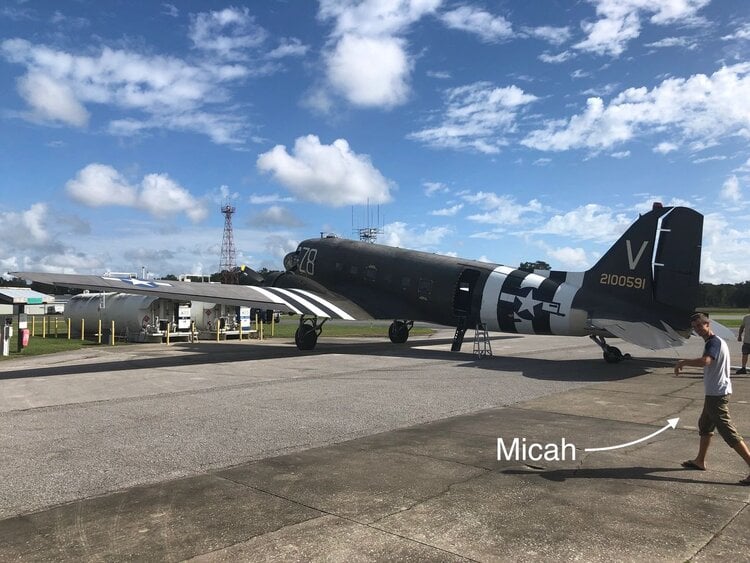
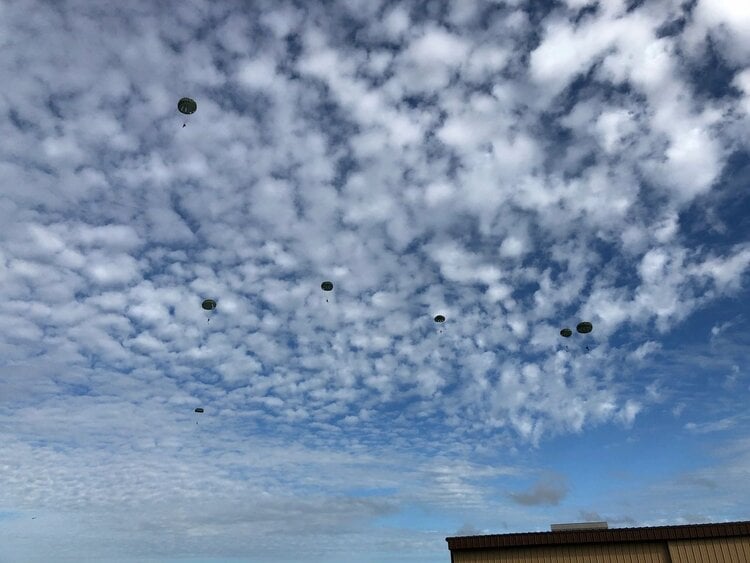
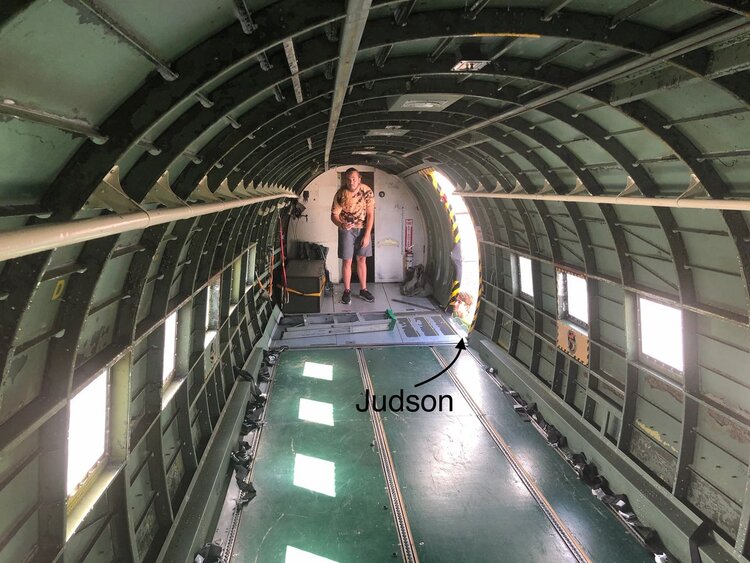
TRAINING DAY 7
October 24, 2020|Paramotor, PPG, Training
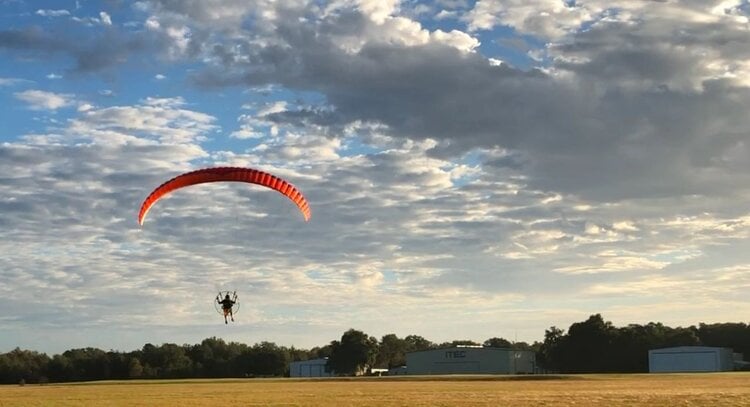 Today, October 24, 2020, I shed my earthly ties, ran forward into the wind, and took to the skies. That’s right, we took our first solo flights today.
Today, October 24, 2020, I shed my earthly ties, ran forward into the wind, and took to the skies. That’s right, we took our first solo flights today.
The day started off as it normally does with a beautiful sunrise. We setup to do some taxi practice. Taxi practice involves putting the motor on our back and kiting. However, if both us and the instructor feel comfortable and confident, they will tell us to roll on power and take off into the air.
Bob, Jared, and Nate (the other students with me), all made it up into the air on their second taxi attempt. An amazing accomplishment paid by long days of practice. Nate was first into the air, followed by Bob, and then Jared. I couldn’t be more proud of my fellow classmates.
Next up was me on a 28 meter wing. I was sharing a wing with Jared so I had to wait. That worked out as it gave me more time to mellow out my nerves. As I geared up, Micah warmed up the paramotor. I then hefted that big butt fan onto my back. I believed myself to be mentally ready. After all, I was super happy with my towing practice the day before.
we laid out the wing and clipped into my harness. Did my preflight checks – legs, waist, chest, and chin straps were all good to go. My carabiners were locked. Brakes clear to pulley. I grabbed the As. Chest out. Find the center tension on the wing. Two steps back. Deep breath. And on command I started my forward run. The wing rose into the air.
Unfortunately, the first attempt failed and the wing came back down. Too much breaks and not enough forward momentum. It’s not easy running with 60+ pounds on your back. Micah helped me reset the wing for my second attempt to taxi.
On the second attempt, the wing came up perfectly. I glanced left to check the wing was up over my head in a good position. Micah’s voice came over the radio – roll on a bit more power. And then, more power. As I continued my forward progress, the steps became lighter and eventually I was running on just the tips of the grass and then just the air. At full power, the wing climbed and the ground dropped away. I was flying!
I continued to climb and stowed my right brake so I can scoot the seat forward to get more comfortable. As I continued to climb, I could feel my panic begin to grow. I tried to focus on the commands coming over the headset. Then the wing started to oscillate and I was unable to return to a stable flight. This increased my panic and I struggled to maintain altitude. Next, the wind made me crab – flying sideways even though I was pointing forward. All these things fed into my panic and turning what should have been an exhilarating flight into a terrifying ordeal.
As I turned for the final leg, I lined up for landing. At about 100 feet, I came out of my seat. At about 75 feet, I reduced power. The ground was rising fast – yikes. I listed to Micah and tried to maintain control without the instinctual pulling of the breaks. I think I did ok but I did flare a little hard a tad early causing me to ballon up and then right back down landing squarely on my feet. Sadly, this also meant that the entire weight of the paramotor was instantly present and I dropped to a knee under the weight. Not the most elegant landing but at least it wasn’t a butt landing or, worse, a face plant.

I was a bit shaken from the first flight. I just did not feel like I had been in control at all during that flight. Yes, I managed to steer the wing in the general direction I wanted to go but it felt like I was pulling right break the entire time. Worse, I expected to have been more comfortable in the air by this point. I had done two tandems, a tow, and now a solo flight. All of which were at a decent altitude.
With so much going on in my head, I opted to pass on additional flights that morning while I processed everything I experienced. Emotions were definitely high. Keep in mind, this has been something I’ve wanted to do since I was a kid and have been planning in earnest for more than a year. Hitting a brick wall in my head deflated me emotionally.
We wrapped up the rest of the morning with our usual debrief. We watched the videos we had taken of each other to critique our flights. We pointed out the good, the bad, and the ugly. While I wasn’t happy with my progress, we all managed to make it into the air. To commemorate this monumental occasion, we were each given a coin. A tradition to signify that we had taken our first solo flight. This may not mean much to most people, but to me, it was a special token that I will always have to remember this experience.

We broke for lunch and I headed out. I spent the rest of the day thinking about my experience. Specifically, whether it makes sense for me to continue pushing myself into the sky given my ongoing anxiety with flying. On the one hand, I’m not a quitter. It’s just not something I want to do. On the other hand, I keep hitting this mental wall and it is highly unlikely I will ever be able to get into the air comfortably.
When I got back to training, I spoke with Micah and described my concerns. I wanted to try again before making any decisions since the first flight is always a little sketch for students. Micah swapped out wings to a 30 meter. The larger wing would help prevent the oscillations. I setup for another run, clipped in, did my checks, and then ran into the wind. That big ass boat of a wing went up and I rolled on power. Just like before, I climbed up into the sky and the ground fell away.
The flight wasn’t much better in terms of anxiety, but the oscillations weren’t as bad. I still had issues with the height, but we had a lot more area to fly since the airport wasn’t as busy in the evening. Micah set me up for a long landing path – straight and high enough to provide small adjustments on approach. At 100 feet, out of the seat. At 75 I rolled off power. At about 50 feet, I cut the engine. Pulled breaks slightly and then, as the ground rushed up, I applied pressure. I managed to land upright on and my feet. I ran forward, turned, and kited the wing to the ground. Successful landing. Admittedly, that felt a lot better than the morning session.

Micah ran over and we celebrated another victory against my fears and anxiety. I don’t feel better about flying but I also don’t feel good about quitting. I told Micah I would come back again for Training Day 8 and continue to try to push through my mental wall. It is unlikely I will ever get past this fear. But I can say that I tried and perhaps that’s good enough.
For now, I will focus on my successful accomplishments of the day.
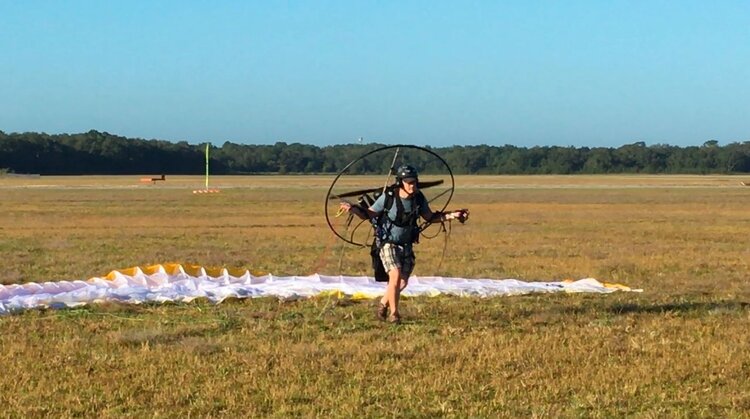
TRAINING DAY 8
October 25, 2020|Paramotor, PPG, Training
A new day of PPG training brings a new promise of facing my fear and advancing my skill as a pilot (not necessarily in that order). The day started off at 7:30am with a bit of early morning fog. We had to wait around for the sun to burn off the fog so we could take off. As PPG pilots, especially new ones, we are not allowed to fly when there is ground cover. By around 8:30am, the fog had mostly evaporated.
We headed out to the field and started laying out our wings. With no wind, there would be a lot of effort expended to get those wings up high over our heads. Since I’m flying with the 30 meter, we opted to wait a little bit longer for some wind to pick up. It would have been a lot of running to get all that wing into the air.
Around 9am, I put that butt fan on my back and hooked into the wing. Deep breath. Off we go with a run and, once that wing was up, I rolled on power. Running until the ground fell away. This first morning flight marks my fourth venture into the sky as a solo flight. Today, Micah had me practice weight shifting to make turns. I stowed the breaks and held onto the risers as I used my weight to lean into a turn. Letting go of those brakes took a great deal of effort. Then there’s the lean – essentially looking way down to the ground as I use my weight to get the wing to turn.
Honestly, the weight shifting was kind of fun once you get past the fear of falling out of the chair at 500 feet. I made a few right-hand pattern turns around the airfield and then setup for a landing. Micah had me start far and high to line up for my landing. At 100 feet, out of the seat. At 75 feet, power off. At about 10 feet I start to apply brake pressure and then, around 6 feet, I apply full breaks and feel the ground meet my feet. Run, run, run – turn and kite the wing to the ground. Awesome flight. Awesome landing.
I setup for my next flight. The wind changed so we needed to head into a new direction. I started to run forward but the wing was rolling left. I glanced to the left and pulled right brake to get the wing back overhead. Then, BAM – I stepped into a turtle hold and crumpled to the ground. I got up and had a huge knot on my shin. I was tempted to try again but Micah was worried I might be hyped on adrenaline and not aware of a serious injury. I agreed and dismounted from the wing. I went back to the hanger to ice my leg. That was the end of flying for the morning.
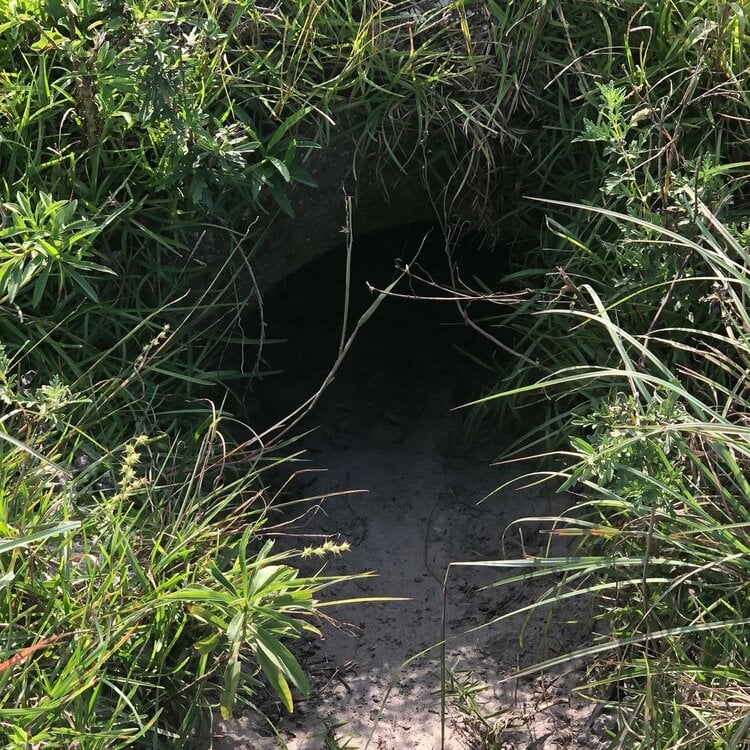
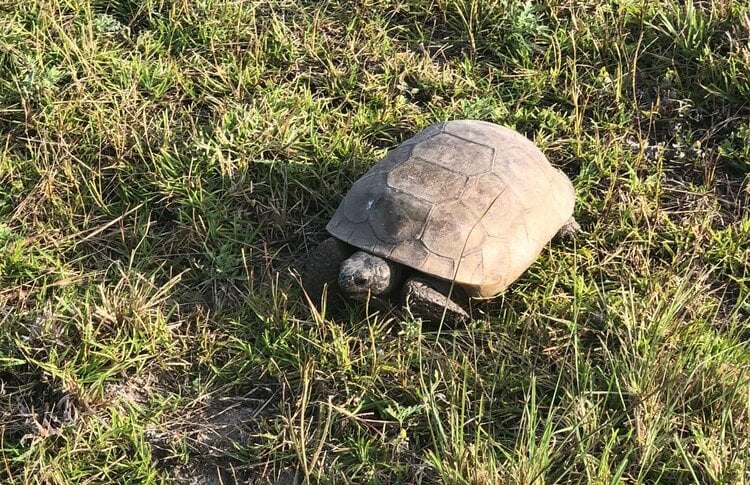
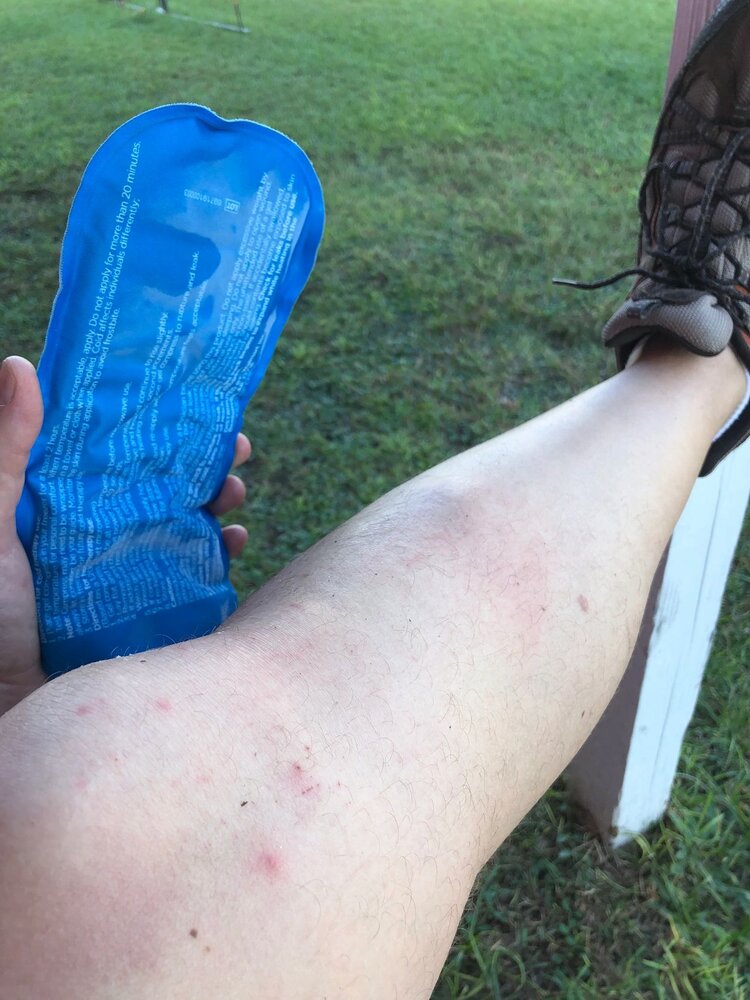
After lunch and back at the hanger for training, my leg was feeling better. It may have a nice bruise but that’s not going to prevent me from trying again. The wind had picked up by the evening making it a lot easier to get that big wing up. I setup and hooked in ready for my next solo attempt. Micah did a quick inspection and then I was off running into the wind. Up I went fairly easily. I did a couple of laps using our usual right-hand pattern and then Micah lined me up for a landing. I came dropped in, applied breaks, flared, and landed on my feet, running forward until I kited the wing down. We did two more flights before wrapping for the day.
In total, I’ve done six solo flights. While my fear is still very much present, I am starting to feel more comfortable and confident in the air. I believe we hit a new altitude record of 500 feet today. The larger wing definitely helps – it plows through rough air and has nearly no oscillation. I’m closing out the day on a positive note and feeling great about where I am in my progress. A special thanks to Micah for talking me off the ledge and encouraging me to keep going in the training even though my fear made me want to drop out. He’s been extremely supportive and talks to me while I fly helping to keep my mind off the fear. I will be forever grateful to the folks at Aviator PPG for helping me achieve a lifelong dream.
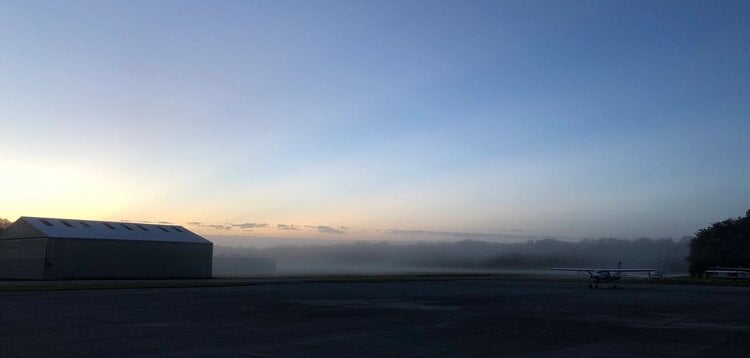
TRAINING DAY 9
October 26, 2020|Paramotor, PPG, Training
The morning started off around 7:15am with a bit of fog. That’s likely to be an ongoing theme this time of year in Florida. High humidity and cooler temps in the morning. While it sure is pretty, that fog prevents us from taking off. We end up waiting around for the sun to burn off or the wind to blow out the fog. Around 8am, the fog had lifted enough for us to head out to the field and setup to send it.
Two students went up but a second fog rolled in about 20 feet off the ground. While the students were above and could see the ground and had 1 mile of visibility (required for ultralights), the instructors were having a difficult time seeing the students to call out maneuvers. At that point, the Judson and Micah had the guys come back down and wait out the second fog.
Around 8:45am, the second fog had mostly dissipated and we all setup to get into the air. I was first up and launched into the wind. Climbing to about 200-300 feet and starting my right-hand pattern around the airfield. There was still a slight bit of fog I flew through. It was surreal…and a bit bumpy.
I came in for a landing and brought it down. Unfortunately, I slipped on the wet grass. Not my most graceful of landings but I still didn’t land on my butt or face. That’s a win.
Back on the ground, I setup for my next flight but the wing didn’t cooperate. It rolled to the side and came back down. Micah helped me get the wing sorted and I tried again. Launched into the wind and climbed right up into the air. I focused on using weight shifting to improve my turning.
Coming around, I lined up for a landing. This time, Micah had me try a touch-n-go. I came down with the motor at idle but still on, applied break pressure, touched the ground and started running. Once the wing stabilized back over head, Micah had me roll on power. The ground started to drop away and I was back up again. My first touch-n-go landing was a success. Amazing!
Back up into the sky. The wind was picking up and, with the sun climbing, the thermals were beginning to stir. Micah said. “that’s Mother Nature telling you it’s time to come down.” I lined up for my final landing. I came back down but was a bit off on my braking so didn’t come down quite as graceful as I had wanted. I need to continue practicing my landing technique. Gauging when to pull brakes to get the landings just right is a tough skill to learn but with more time, I’m sure we’ll get there. That wrapped up our morning session and we broke for lunch around 10:30am.
Back at the airfield at 4:50pm and ready for the afternoon session. Unfortunately, the weather isn’t cooperating. Winds are 10mph at the ground and gusting 15+mph a few hundred feet up. A bit too rough for this newbie. We did some kiting practice, which is a LOT easier now that we’ve spent so much time practicing. Prior to training, I couldn’t kite at all in these kinds of winds. Now, I was able to kite with the Roadrunner wing without issue. In fact, I can even stand still and steer the wing overhead. Not too shabby.
That concludes training day nine. Looking forward to training day ten tomorrow.

TRAINING DAY 10
October 27, 2020|Paramotor, PPG, Training
True to form, Florida weather has proven difficult yet again. We arrived at 7:30am with no fog but steady winds of 10mph at ground level and gusting 15+mph at 200-300 feet. Micah went up to check the air and ended up parked around 1000 feet. When he turned with a tailwind, his ground speed was incredibly fast. Needless to say, it was not student friendly. Unfortunately, the rest of the week is looking to be the same or worse. That means our last window for flights might be this evening if the wind calms down. We broke for lunch and will reconvene at 3pm for the remaining class modules and will call the shot for flights depending on the weather.
We reconvened at 3pm to do more class room lecture. Today was on safety. This is saved for last to prevent scaring the crap out of students. Some of the videos definitely create anxiety. The higher altitude issues, especially those requiring a reserve, give pause to anyone looking to leave and jump straight into crazy antics. Well, at least those students without a death wish. Needless to say, I can see why the safety class is saved for the end of training.
As our last exercise, we practiced a reserve toss. This involves implementing the “OODA” loop; Observe, Orient, Decide, and Act. During an incident where you believe the main wing is fouled to the point of no return, you need to think and react. Kill the power, stow the breaks, visually locate the reserve handle, pull, and toss to clear air. Next, you want to pull in the main wing to prevent re-inflation or getting in the way of the reserve. You then want to get into position to drop to the ground by putting your feet together and slightly bend your knees. All of this seems like a lot to accomplish when you’re literally falling through the air. Hopefully I am never in a situation where this needs to be executed.
Unfortunately, a storm rolled in and squashed any hope of doing flights this evening. It doesn’t look like there will be further opportunities for flight between now and Friday. We all agreed to come in tomorrow morning at 7:45am in the hopes of an early morning flight. If not, we’ll use that time to answer any last minute questions and say farewell to each other as we leave to return to normal life.
Check out this scary cloud formation…

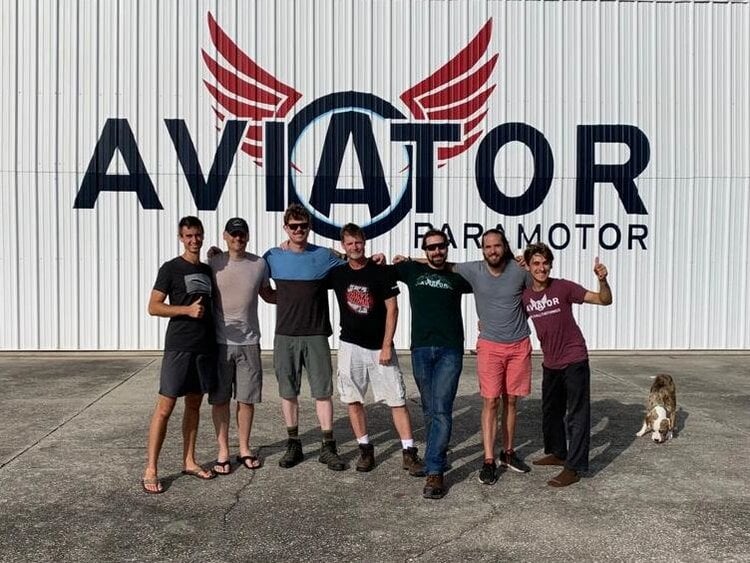
TRAINING DAY 11 (THE END?)
October 28, 2020|Paramotor, PPG, Training
My alarm clock went off at 5:45am. Ugh, it is so early and I ache in all sorts of places. But there is a chance of an early morning flight. Time to get up and get ready.
We’ve been bringing in donuts a few times for the team. I decided to get something special on what is likely our last day of training. I stopped by Dunkin and grabbed a bunch of egg, bacon, cheese, English muffin sandwiches for the team (plus a few for my parents who have put up with my crazy schedule for the past two weeks).
Barely getting down a few gulps of coffee, it was time to roll out to the field. The weather was looking promising. A light fog was floating around 100 feet but that didn’t seem to deter anyone.
We laid out our wings on the damp ground. Did our preflight checks. Warmed up the engines. Clipped in and performed prelaunch checks. Then it was go time. We all took turns heading into the sky.
With the fog as our ceiling around 300 feet, we flew low around 200 feet. We setup to performed our usual right-hand pattern around the airfield. I wanted to practice my take off and landings so I came down and did my touch-n-go a few times. I landed awkward on one so went ahead and stopped so I could reset. I think that was about five flights putting me at fourteen total flights.
Micah had me swap out my Mojo 30 meter for the 26 meter Spyder 3. This was the wing I had planned to buy. Getting to fly it here at training would give me an idea of what to expect under Micah’s mentorship. The wing came up much easier but I did have to run a little further than with the Mojo. Micah had told me that I would need to pull a little brake to get up easier than I had been doing with the Mojo.
As I run forward, I checked my wing tips to ensure we were good and started to roll on power. Pulling a small amount of brake, the steps got lighter and eventually, the ground dropped away.
The Spyder definitely has a different flight dynamic than the Mojo. Turns seemed more deliberate with a tad more roll. The air was getting a bit bumpy so we opted to bring it in for a landing and call it a day. As I came in for the landing, I got out of my seat and used weight shifting and a very small amount of break pressure to line up. At about 6-8 feet, I applied breaks to my shoulders. This caused the Spyder to swoop slightly and level off at about 4 feet above the ground. I then pulled breaks down to my seat and stepped back onto the ground. I was overly excited and spun too soon rather than running and kiting the wing down. But it was a good final flight for my training adventure.
Afterwards, I spoke with Micah and we both agreed. If I do buy the Spyder, it would probably be best to get the 28 meter as that matches my current skill level and flying style. That is to say, I’m partial to slower flying right now. Perhaps in the future I can work my way down to smaller and faster wings.
We cleaned up, stowed our wings, did a wipe down to check over the paramotor, and headed back to the hanger for our usual debrief. I was talking to my wingman, Bob Hicks, about our adventure. Both of us were happy with the decision to attend Aviator PPG. Bob had been a great teammate throughout all of this journey. He aptly noted, this is like going swimming – it’s cold at first, but as you continue in, you get used to the temperature and start enjoying the experience. In a similar way, we launched ourselves into the sky and over time, we started to enjoy flying.
This has been a monumental accomplishment in my life. Something I thought out of reach for many years. While I may still have some trepidation about flying, this is certainly a sport I could see myself continuing. In that regard, this may be the end of training but may not be the end of my journey.
I am forever grateful to my wife for supporting this crazy idea, my family and teammates for their support, and the incredible mentorship from Micah and Judson with Aviator PPG. I will always remember this experience and encourage others to follow their dreams.

